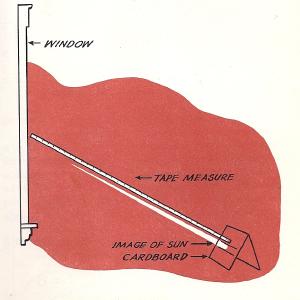Post
Measuring the Sun
11 May 2013
There’s been lots of talk about the annular eclipse that occurred yesterday, but unless you happen to live in Australia, you probably didn’t get a chance to see it. You can, however make your own solar observation to measure the size of the Sun. This experiment uses the principle of parallax, and all you need is a sunny window, some cardboard, a pencil, and a tape measure.
Start with a sunny window, and block off as much of the light as you can, except for an area you will over with a piece of cardboard (or poster board). You don’t have to block all the light, but the more you block off, the easier it will be do to the experiment. Then poke a small hole in the cardboard and put in into position. As a result, you should have a single beam of light which shines through the hole. If you move your hand closer or farther away in the beam, you should see an image of the Sun on your hand which gets larger the farther away your hand is from the hole. Next take a piece of paper or cardboard and draw two parallel lines on it, an inch apart. Then place this in the beam of light, and move it closer or farther along the beam until the disk of light just fills the space between your lines. Try to ensure that your disk looks circular, and not oblong. When you are lined up in the beam, measure the distance from the image. Once you have your measurement, all you need is a little math.
 Don Herbert
Don HerbertThe ratio of the diameter of your image (1 inch) and the distance of your image from the hole (which you’ve measured) is the same as the ratio of the diameter of the Sun (which you want to know) and the distance from the hole to the Sun (93,000,000 miles). If we call your distance measurement x in inches, and the diameter of the Sun D, then D divided by 150,000,000 (the distance to the Sun in kilometers) is the same as 1 divided by x. That is: D/150,000,000 = 1/x.
If you solve this equation, you’ll find that the diameter of the Sun in miles is simply 93,000,000 divided by the distance you measured in inches. If you give this experiment a try, see how your result compares to the actual diameter of the sun, which is 1,400,000 km. Since total eclipses occur, we also know the Moon has about the same apparent diameter as the Sun, so you can use the same equation, but with the Moon’s distance (380,000 km) to determine the size of the Moon.